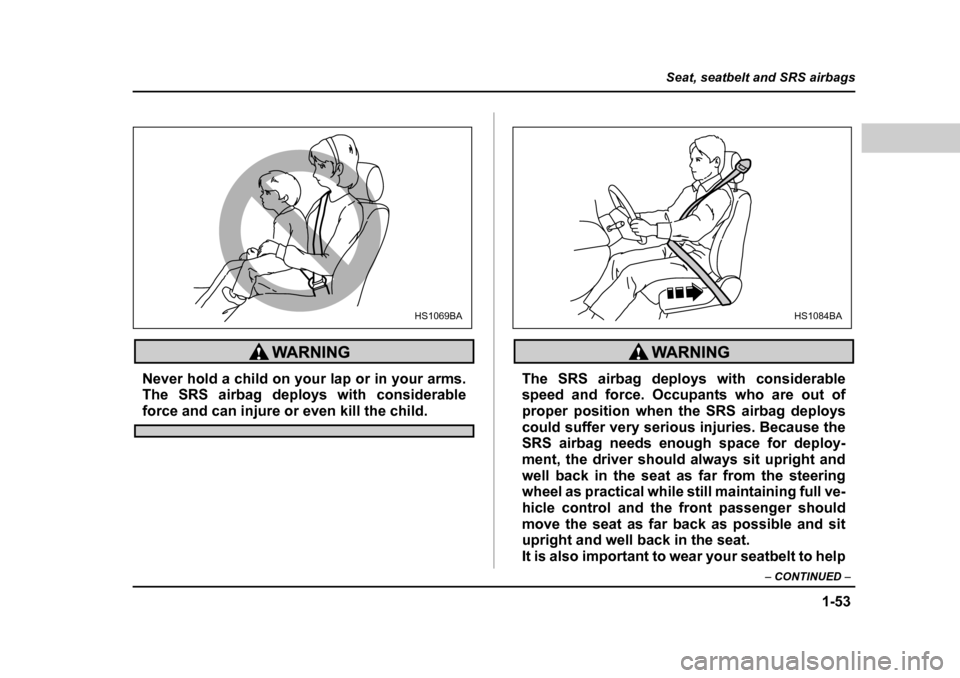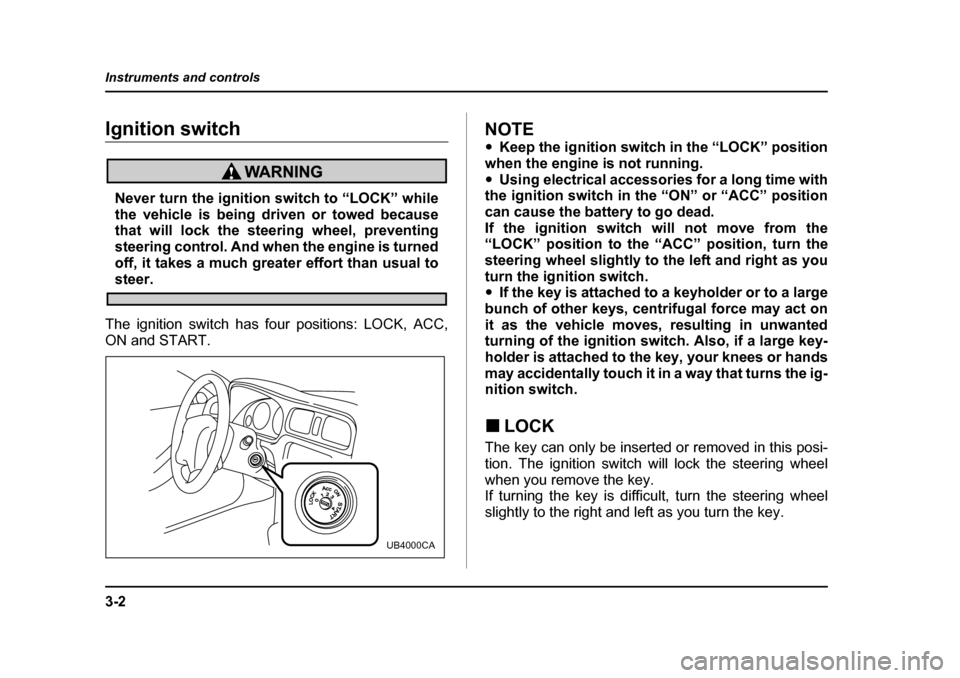2005 SUBARU BAJA wheel
[x] Cancel search: wheelPage 78 of 469

1-53
Seat, seatbelt and SRS airbags
– CONTINUED –
Never hold a child on your lap or in your arms.
The SRS airbag deploys with considerable
force and can injure or even kill the child.
The SRS airbag deploys with considerable
speed and force. Occupants who are out of
proper position when the SRS airbag deploys
could suffer very serious injuries. Because the
SRS airbag needs enough space for deploy-
ment, the driver should always sit upright and
well back in the seat as far from the steering
wheel as practical while still maintaining full ve-
hicle control and the front passenger should
move the seat as far back as possible and sit
upright and well back in the seat.
It is also important to wear your seatbelt to help
HS1069BAHS1084BA
Page 79 of 469

1-54
Seat, seatbelt and SRS airbags
avoid injuries that can result when the SRS air-
bag contacts an occupant not in proper posi-
tion such as one thrown toward the front of the
vehicle during pre-accident braking.
Do not put any objects over the steering wheel
pad and dashboard. If the SRS frontal airbag
deploys, those objects could interfere with its
proper operation and could be propelled inside
the vehicle and cause injury.
Do not attach accessories to the windshield, or
fit an extra-wide mirror over the rear view mir-
ror. If the SRS airbag deploys, those objects
could become projectiles that could seriously
injure vehicle occupants.
HS1085BA
HS1086BA
Page 81 of 469

1-56
Seat, seatbelt and SRS airbags
The SRS airbag can function only when the ignition
switch is in the “ON” position.
If the front sub sensors inside the both front fenders
and the impact sensors in the airbag control module
detect a certain predetermined amount of force during
a frontal collision, the control module sends signals to
the frontal airbag modules instructing them to inflate
the SRS frontal airbags. Then both airbag modules
produce gas, which instantly inflates driver’s and pas-
senger’s SRS frontal airbags. After the deployment,
the SRS airbags immediately start to deflate so that
the driver’s vision is not obstructed. The time required
from detecting impact to the deflation of the SRS air-
bag after deployment is shorter than the blink of aneye.
The front passenger’s SRS frontal airbag deploys to-
gether with driver’s SRS frontal airbag even when no
one occupies the front passenger’s seat.
When the SRS frontal airbags deploy, the driver’s and
front passenger’s seatbelt pretensioners operate at
the same time.
Although it is highly unlikely that the SRS airbag would
activate in a non-accident situation, should it occur,
the SRS airbag will deflate quickly, not obscuring vi-
sion and will not interfere with the driver’s ability to
maintain control of the vehicle.
When the SRS airbag deploys, a sudden, fairly loud
inflation noise will be heard and some smoke will be
released. These occurrences are normal result of the
deployment. This smoke does not indicate a fire in thevehicle.
Do not touch the SRS airbag system compo-
nents around the steering wheel and dash-
board with bare hands right after deployment.
Doing so can cause burns because the compo-
nents can be very hot as a result of deployment.
The SRS frontal airbag is designed to deploy in the
event of an accident involving a moderate to severe
frontal collision. It is basically not designed to deploy
in lesser frontal impacts because the necessary pro-
tection can be achieved by the seatbelt alone. Also, it
is basically not designed to deploy in side or rear im-
pacts or in roll-over accidents because deployment of
the SRS frontal airbag would not help the occupant in
those situations. The SRS airbag is designed to func-
tion on a one-time-only basis.
SRS airbag deployment depends on the level of force
Page 87 of 469

1-62
Seat, seatbelt and SRS airbags
low, we recommend that you have an autho-
rized SUBARU dealer perform the work. The
SRS airbag control module, impact sensors
and airbag modules are stored in these areas. �y
Under the center console
�y Inside each front fender
�y Steering wheel and column and nearby areas
�y Top of the dashboard on front passenger’s
side and nearby areas
�y Inside each center pillar
In the event that the SRS airbag is deployed, re-
placement of the system should be performed
only by an authorized SUBARU dealer. When the
components of the SRS airbag system are re-
placed, use only genuine SUBARU parts.
To ensure their long-term reliability, the SRS airbags
must be inspected by a SUBARU dealer ten years af-
ter the date of manufacture, which is shown on the cer-
tification label attached to the driver’s door.
NOTE
In the following cases, contact your SUBARU deal-
er as soon as possible. �y The front part of the vehicle was involved in an
accident in which the SRS frontal airbags did not deploy.�y
The pad section of the steering wheel or front
passenger’s frontal airbag cover is scratched,
cracked, or otherwise damaged. �„ Precautions against vehicle modifica- tion
�yTo avoid accidental activation of the system
or rendering the system inoperative, which may
result in serious injury, no modifications
should be made to any components or wiring of
the SRS airbag system.
This includes following modifications:
�yInstallation of custom steering wheels
�y Attachment of additional trim materials to
the dashboard
�y Installation of additional electrical/electronic
equipment such as a mobile two-way radio on
or near the SRS airbag system components
and/or wiring is not advisable. This could inter-
fere with proper operation of the SRS airbag
system.
Page 124 of 469

3-1
3
Instruments and controls
Ignition switch .............................................. 3-2 LOCK .................................................................. 3-2
ACC .................................................................... 3-3
ON ....................................................................... 3-3
START ................................................................ 3-4
Key reminder chime .......................................... 3-4
Ignition switch light (if equipped) .................... 3-4
Key interlock release (AT vehicles) ................. 3-4
Hazard warning flasher ................................ 3-5
Meters and gauges ....................................... 3-6 Speedometer ..................................................... 3-6
Odometer/Trip meter ........................................ 3-6
Tachometer ........................................................ 3-7
Outside temperature indicator (if equipped) .. 3-7
Fuel gauge ......................................................... 3-8
Temperature gauge ........................................... 3-8
Warning and indicator lights ....................... 3-9 Seatbelt warning light and chime .................... 3-9
SRS airbag system warning light .................... 3-10
CHECK ENGINE warning light/Malfunction indicator lamp ................................................. 3-10
Charge warning light ........................................ 3-11
Oil pressure warning light ................................ 3-12
AT OIL TEMPerature warning light (AT vehicles) ................................................... 3-12
ABS warning light ............................................. 3-12
Brake system warning light ............................. 3-13
Door ajar warning lights ................................... 3-14
Switchback door indicator light ...................... 3-14
Low fuel warning light ...................................... 3-14
All-Wheel Drive warning light (AT vehicles) ... 3-14 Security system status indicator light
(if equipped) .................................................... 3-15
Selector lever position indicator (AT vehicles) ................................................... 3-15
Gear position indicator (Turbo-AT vehicles) .. 3-16
Turn signal indicator lights .............................. 3-16
High beam indicator light ................................. 3-16
Cargo lamp indicator light ............................... 3-16
Cruise control set indicator light .................... 3-16
Clock .............................................................. 3-17
Light control switch ...................................... 3-18 Headlights ......................................................... 3-18
High/low beam change (dimmer) .................... 3-19
Headlight flasher ............................................... 3-19
Daytime running light system ......................... 3-20
Turn signal lever ........................................... 3-20
Illumination brightness control ................... 3-21
Parking light switch ...................................... 3-22
Fog light button ............................................. 3-23
Wiper and washer ......................................... 3-23 Windshield wiper and washer switches ......... 3-25
Rear window defogger button ..................... 3-26
Windshield wiper deicer (if equipped) ........ 3-27
Mirrors ............................................................ 3-28 Inside mirror ...................................................... 3-28
Outside mirrors ................................................. 3-30
Tilt steering wheel ......................................... 3-33
Horn ................................................................ 3-34
Page 125 of 469

3-2
Instruments and controls
Instruments and controlsIgnition switch
Never turn the ignition switch to “LOCK” while
the vehicle is being driven or towed because
that will lock the steering wheel, preventing
steering control. And when the engine is turned
off, it takes a much greater effort than usual to
steer.
The ignition switch has four positions: LOCK, ACC,
ON and START.
NOTE �y Keep the ignition switch in the “LOCK” position
when the engine is not running. �y Using electrical accessories for a long time with
the ignition switch in the “ON” or “ACC” position
can cause the battery to go dead.
If the ignition switch will not move from the
“LOCK” position to the “ACC” position, turn the
steering wheel slightly to the left and right as you
turn the ignition switch. �y If the key is attached to a keyholder or to a large
bunch of other keys, centrifugal force may act on
it as the vehicle moves, resulting in unwanted
turning of the ignition switch. Also, if a large key-
holder is attached to the key, your knees or hands
may accidentally touch it in a way that turns the ig-
nition switch. �„ LOCK
The key can only be inserted or removed in this posi-
tion. The ignition switch will lock the steering wheel
when you remove the key.
If turning the key is difficult, turn the steering wheel
slightly to the right and left as you turn the key.
UB4000CA
Page 132 of 469

3-9
Instruments and controls
– CONTINUED –
the engine coolant at this temperature range and high
revving operation when the engine is not warmed up
enough should be avoided.Warning and indicator lights
Several of the warning and indicator lights come on
momentarily and then go out when the ignition switch
is initially turned to the “ON” position. This permits
checking the operation of the bulbs.
Apply the parking brake and turn the ignition switch to
the “ON” position. The following lights come on:
Seatbelt warning light
SRS airbag system warning light
CHECK ENGINE warning light / Malfunction indica- tor lamp
Charge warning light
Oil pressure warning light
AT OIL temperature warning light (AT vehicles) ABS warning light
Brake system warning light
All-Wheel Drive warning light (AT vehicles)
If any lights fail to come on, it indicates a burned-out
bulb or a malfunction of the corresponding system.
Consult your authorized SUBARU dealer for repair. �„ Seatbelt warning light and chime
When the ignition switch is turned to the “ON” position,
the seatbelt warning light will come on and the remind-
Page 137 of 469

3-14
Instruments and controls
If the brake system warning light should come on while
driving (with the parking brake fully released and with
the ignition switch positioned in “ON”), it could be an
indication of leaking of brake fluid or worn brake pads.
If this occurs, immediately stop the vehicle at the near-
est safe place and check the brake fluid level. If the flu-
id level is below the “MIN” mark in the reservoir, do not
drive the vehicle. Have the vehicle towed to the near-
est SUBARU dealer for repair. �„
Door ajar warning lights
The specific door ajar warning light comes on if any
door is not fully closed.
Always make sure this light is out before you start to
drive. �„ Switchback door indicator light
While the ignition switch is in the “ON” position, the
switchback door indicator light comes on when the
switchback door is open.
While the ignition switch is in the “LOCK” or “ACC” po-
sition, the switchback door indicator light flashes for
about 20 seconds and goes off when the switchback
door is open. �„
Low fuel warning light
The low fuel warning light comes on when the tank is
nearly empty about 2.6 US gal (10.0 liters, or 2.2 Imp
gal). It only operates when the ignition switch is in the“ON” position.
NOTE
This light does not go out unless the tank is re-
plenished up to an internal fuel quantity of about
3.7 US gal (14 liters, 3.1 Imp gal).
Promptly put fuel in the tank whenever the low
fuel warning light comes on. If the engine mis-
fired as a result of an empty tank, resulting cat-
alyzer damage could cause damage to the tur-
bocharger.
�„ All-Wheel Drive warning light
(AT vehicles)
The All-Wheel Drive warning light comes on when the
ignition switch is turned to the “ON” position and goes
out after about two seconds.